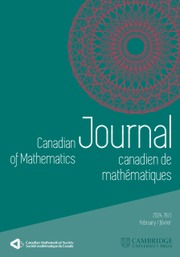Article contents
Octahedral Galois Representations Arising From  $\mathbf{Q}$ -Curves of Degree 2
$\mathbf{Q}$ -Curves of Degree 2
Published online by Cambridge University Press: 20 November 2018
Abstract
Generically, one can attach to a  $\mathbf{Q}$ -curve
$\mathbf{Q}$ -curve  $C$ octahedral representations
$C$ octahedral representations  $\rho $ :
$\rho $ :  $\text{Gal}\left( \mathbf{\bar{Q}}/\mathbf{Q} \right)\,\to \,\text{G}{{\text{L}}_{2}}\left( {{{\mathbf{\bar{F}}}}_{3}} \right)$ coming from the Galois action on the 3-torsion of those abelian varieties of
$\text{Gal}\left( \mathbf{\bar{Q}}/\mathbf{Q} \right)\,\to \,\text{G}{{\text{L}}_{2}}\left( {{{\mathbf{\bar{F}}}}_{3}} \right)$ coming from the Galois action on the 3-torsion of those abelian varieties of  $\text{G}{{\text{L}}_{2}}$ -type whose building block is
$\text{G}{{\text{L}}_{2}}$ -type whose building block is  $C$ . When
$C$ . When  $C$ is defined over a quadratic field and has an isogeny of degree 2 to its Galois conjugate, there exist such representations
$C$ is defined over a quadratic field and has an isogeny of degree 2 to its Galois conjugate, there exist such representations  $\rho $ having image into
$\rho $ having image into  $\text{G}{{\text{L}}_{2}}\left( {{\mathbf{F}}_{9}} \right)$ . Going the other way, we can ask which mod 3 octahedral representations
$\text{G}{{\text{L}}_{2}}\left( {{\mathbf{F}}_{9}} \right)$ . Going the other way, we can ask which mod 3 octahedral representations  $\rho $ of
$\rho $ of  $\text{Gal}\left( \mathbf{\bar{Q}}/\mathbf{Q} \right)$ arise from
$\text{Gal}\left( \mathbf{\bar{Q}}/\mathbf{Q} \right)$ arise from  $\mathbf{Q}$ -curves in the above sense. We characterize those arising from quadratic
$\mathbf{Q}$ -curves in the above sense. We characterize those arising from quadratic  $\mathbf{Q}$ -curves of degree 2. The approach makes use of Galois embedding techniques in
$\mathbf{Q}$ -curves of degree 2. The approach makes use of Galois embedding techniques in  $\text{G}{{\text{L}}_{2}}\left( {{\mathbf{F}}_{9}} \right)$ , and the characterization can be given in terms of a quartic polynomial defining the
$\text{G}{{\text{L}}_{2}}\left( {{\mathbf{F}}_{9}} \right)$ , and the characterization can be given in terms of a quartic polynomial defining the  ${{S}_{4}}$ -extension of
${{S}_{4}}$ -extension of  $\mathbf{Q}$ corresponding to the projective representation
$\mathbf{Q}$ corresponding to the projective representation  $\bar{\rho }$ .
$\bar{\rho }$ .
Information
- Type
- Research Article
- Information
- Copyright
- Copyright © Canadian Mathematical Society 2002
References
- 2
- Cited by

